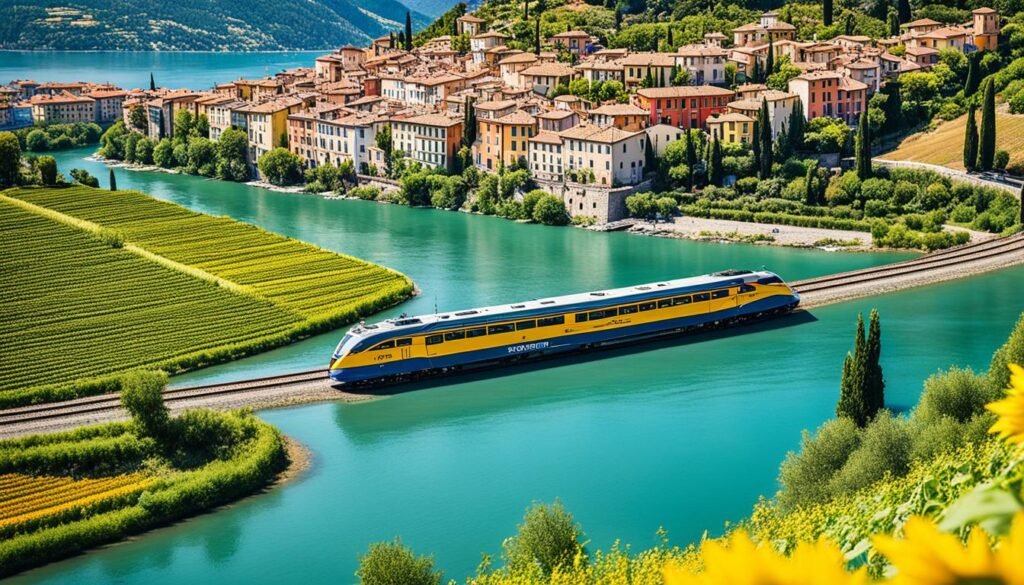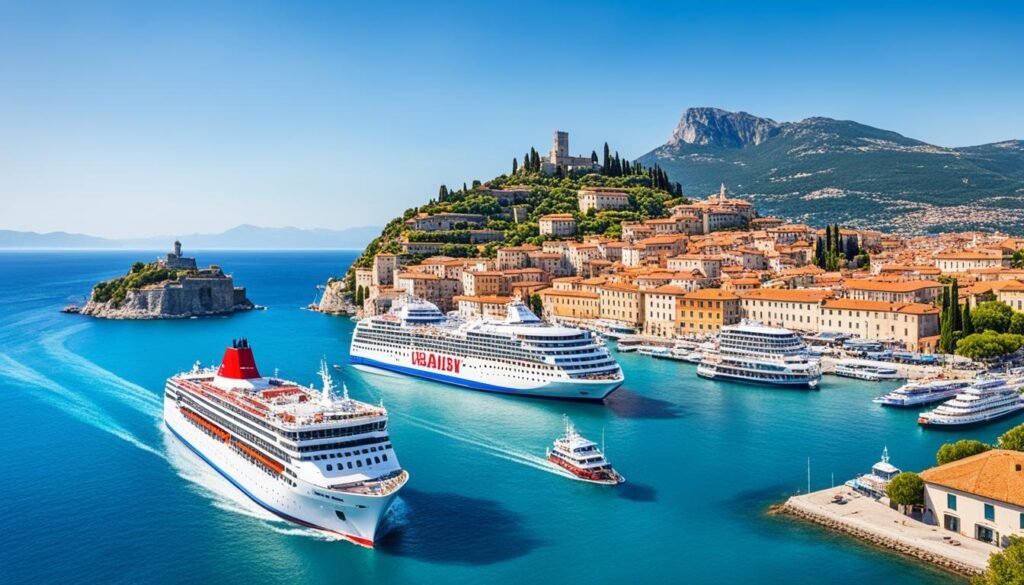Exploring Italy’s vibrant cities and scenic areas is exciting. But many travelers wonder how to travel wisely. Italy has high-speed trains up north and coastal roads in the south. Each way of traveling has its own perks and things to consider. Knowing these can help you have a great time in Italy.
The right way to see Italy is up to you. Some love the train’s speed and ease. Others enjoy driving for the freedom it brings. And for some, taking a bus is the best choice because it’s affordable. Consider what’s important to you. Then, pick the best way to travel to enjoy Italy’s beauty.
Train Travel: The Efficient Way to Explore Italy
Trains are a top choice for moving around Italy, especially if you plan to see Rome, Florence, and Venice. This beautiful country has a vast network of trains run by Trenitalia and Italo. You can pick from fast high-speed trains to slower ones that go through cities and towns.
High-Speed Trains for Rapid Intercity Connections
Italy’s high-speed trains, run by companies like Trenitalia and Italo, zoom at up to 300 km/h. This is much faster than driving. They’re comfy, with places to charge your phone, and you can often catch up online with the free Wi-Fi.
Italy’s Extensive Rail Network
This Italian train system makes traveling by rail easy. It links up cities and towns smoothly, offering fast travel in Italy.
Booking Train Tickets and Discounts
If you book your Italy train tickets ahead of time, you can snag deals. For instance, a fast ride from Rome to Florence could be as cheap as €15. Both Trenitalia and Italo make booking simple online. Plus, check out the Omio website for the best prices and schedules.
Driving in Italy: Embracing the Freedom of the Road
Driving in Italy means you can see beautiful places off the usual path. You get to move at your own speed. This lets you visit charming towns, vast fields, and stunning coastlines easily.
Renting a Car in Italy
In Italy, driving has its hard parts. Finding a car with automatic gear is not easy. You might have to drive one with manual transmission. Cities here are usually crowded. This makes parking hard to find and costly. Also, many ancient city centers don’t allow cars.
Navigating Italy’s Scenic Roads and Highways
Driving on Italy’s highways, called autostrada, means you’ll pay tolls. Drivers in Italy are known to be quick and assertive. But, these roads let you enjoy beautiful regions like Tuscany or the Dolomites up close.
Bus Transportation: An Affordable Option
If you want to save money, consider taking a bus in Italy. Although there’s no single national service, companies like Flixbus link many places. These buses have comfy seats, outlets, and Wi-Fi. They are a good choice if you have time to spare.
Long-Distance Bus Services in Italy
Flixbus makes it easy to visit big cities and small towns across Italy. Their buses connect places like Rome, Milan, Florence, Venice, and even more. You’ll find that bus fares are often cheaper than trains. But, remember, they might take longer to get you there.
Local and Regional Bus Networks
Off the beaten path, buses run by different companies link smaller towns. Exploring areas like Tuscany or Puglia by bus is a good way to see Italy’s local life. It might not be as quick as trains, but it’s kind to your wallet.
 Are there any special passes or cards I should purchase for public transportation in London?
Are there any special passes or cards I should purchase for public transportation in London?
What’s the most convenient way to travel between cities in Italy?
Choosing how to move between cities in Italy depends on a few things like your itinerary, travel style, and budget. Trains stand out as fast and efficient, especially for major cities. They offer both high-speed and local services. If you want to see more, driving gives you freedom but can be tough in cities. For a budget option, buses work well, and for long distances, planes are ideal. To visit islands like Sicily, ferries are the way to go. Mixing different ways of getting around might be the smartest move. Each way of traveling has its pros and cons.
| Transportation Mode | Advantages | Disadvantages |
|---|---|---|
| Trains | – Fastest and most efficient – Extensive network connecting major cities – Comfortable with amenities like power and Wi-Fi |
– Can be more expensive, especially for last-minute booking |
| Driving | – Offers flexibility and freedom to explore off-the-beaten-path areas – Allows you to experience the countryside and scenic routes |
– Challenging in crowded urban centers – Tolls and fuel costs can add up – Parking can be difficult and expensive in cities |
| Buses | – More affordable than trains – Provide access to smaller towns and villages |
– Slower than trains – Require more planning and coordination |
| Planes | – Quickest way to cover long distances | – Airport logistics and costs can be inconvenient – Limited routes within Italy |
| Ferries | – Essential for reaching Italy’s islands like Sicily and Sardinia | – Travel time can be lengthy |
When you seek the most convenient way to travel between cities in Italy, think about balancing time, money, and comfort. Knowing what each option offers helps you pick what matches your travel style and needs best.

Air Travel: Bridging Long Distances Quickly
Italy has flights, but they aren’t very convenient or cost-effective, unless it’s for certain routes. Low-cost airlines, for example, Ryanair and Wizz Air, provide some flight deals. But, you might end up paying more for things like checked bags and picking seats. Also, airports are often far from big cities, leading to extra costs and travel time.
Yet, some trips are better done by flying. For example, going from the mainland to Sicily or Sardinia. Flights are quick while ferries can be slow and not very comfortable. Flying is also a good choice for trips between Venice and the south of Italy, or Milan and Puglia.
Major Airlines and Low-Cost Carriers
In Italy, you have major airlines like Alitalia and ITA Airways. There are also low-cost carriers such as Ryanair, Wizz Air, and easyJet for domestic flights. These cheaper flights are a quicker way to travel long distances, beating out trains and buses.
Airport Connections to Italian Cities
A big thing to think about when flying in Italy is where the airports are. They’re usually on the edge of big cities. So, you’ll need more transportation to get to the city center. This adds time and cost to your trip, making air travel less simple. It’s a good idea to look up airport connections and plan how you’ll get around, whether it’s by train, bus, or a private airport shuttle.
Ferry Services: Connecting the Mainland to Islands
Italy uses ferries to link its mainland to the big islands. They’re also for going between islands and for trips along the coast. Italy ferry services are vital for reaching places like Sicily, Sardinia, and many tiny islands off the coast.
Ferries to Sicily and Sardinia
To get to Sicily, you can take your car on a ferry from Reggio Calabria to Messina. There are also overnight ferries from Naples, Civitavecchia, and Genoa to Palermo. For Sardinia, ferries sail from Olbia, Golfo Aranci, and Porto Torres to places like Livorno and Genoa. These trips usually take over 8 hours.
Coastal and Island-Hopping Ferries
Italy’s many ferry and hydrofoil services let you see the coast and smaller islands. For example, they operate in the Bay of Naples and even in the lakes region. Although it can get tricky to figure out ferry schedules and book tickets, sites such as Direct Ferries help. They give a good look at what’s available, like coastal ferries in Italy and island hopping in Italy.

Private Transfers and Airport Shuttles
If you don’t want to drive or deal with buses, you can use private transfers or airport shuttles in Italy. Companies like Suntransfers and Welcome Pickups provide these services. Their drivers meet you at the airport or train station. This is great if you’re going to places hard to reach by public transport. It’s also good for big groups or people with lots of bags. Although it costs more than public transport, the comfort and ease might be worth it.
Convenience of Door-to-Door Transfers
Private transfers and airport shuttles in Italy make your trip easy. You don’t have to worry about buses or carrying heavy bags. These services are very helpful, especially when you land at a big airport. Your driver takes you straight to your place. This saves you time and trouble.
 What’s the easiest way to travel from Manhattan to JFK Airport in New York City?
What’s the easiest way to travel from Manhattan to JFK Airport in New York City?
These services are perfect for travelers in a hurry or those going to off-the-beaten-path spots. They’re also great for big groups. You avoid the stress of figuring out how to get to your hotel. Though they cost more than public options, the ease and time they save are valuable.
Ridesharing and Taxi Services
Italy has started using modern ways of getting around, including ridesharing. But, these services aren’t the same everywhere in the country. Uber works in Italy, but it has its own rules.
Availability of Rideshare Apps in Italy
In places like Rome and Milan, you can use Uber. Yet, you’ll mostly see the expensive Uber Black cars. This means waiting a lot and paying more. It’s not the best for quick trips around town.
Taxis in Italian Cities
If you need a dependable and cheaper way to move around Italy, try taxis. But, you can’t flag one down on the street. You’ll either find them at taxi stands or hail them using apps like FREE Now and MyTaxi.
With these apps, ordering and paying for taxis is easy and safe, just like with Uber. For shorter trips, this might be the best way to go.
Yet, if you’re traveling far, taxis can get pricey in Italy. For longer distances, check out other ways like trains or buses. Private transfers can sometimes be a good option too, especially between cities and getting around Italian cities.
Comparing Travel Options: Time, Cost, and Convenience
When you’re picking the best way to go between cities in Italy, think about what matters most. Trains are fast and efficient, letting you move quickly between big spots. They’re quick, but can cost a lot if not planned ahead. Driving gives you freedom but has its downsides in Italy’s busy towns, with tolls and gas prices to consider. Buses are cheap but take longer, needing more time and effort to plan. Flights can cover large distances in a jiffy but involve airport hassles and extra costs. And if you’re headed to Italy’s islands, ferries are a must, even if they mean a longer travel time.
Choosing the best transportation method depends on your specific journey. Often, mixing different ways of getting around gives the smoothest trip. Thinking about the time, cost, and convenience of each option lets you plan a trip where you see and do a lot while keeping the stress and costs to a minimum.
| Mode of Transportation | Travel Time | Cost | Convenience |
|---|---|---|---|
| High-Speed Trains | Fastest (2-4 hours) | More expensive, but discounts available | Efficient, with central station locations |
| Driving | Flexible, but can be slower | Moderate to high (fuel, tolls, parking) | Greater flexibility to reach remote areas |
| Buses | Slower than trains | Budget-friendly | Requires more planning, less reliable schedules |
| Flights | Quickest for long distances | Moderate to high, with airport logistics | Convenient for reaching islands, but less so for city-to-city |
| Ferries | Longer travel time | Moderate | Essential for reaching Italy’s islands |
Planning Your Italian Itinerary
Planning a trip to Italy means thinking about how you’ll move around. Tools like Google Maps and Rome2Rio show you how long it takes to travel by train, car, or plane. This helps you create a smart itinerary. Consider what kind of experience you’re looking for. If you want to be flexible and see hidden gems, a rental car is great. But for most sightseeing time, choose Italy’s high-speed trains.
Factoring in Travel Time and Connections
For faraway places or Italy’s islands, flights or ferries are key. Knowing each transportation type’s pros and cons helps find what’s best for you. This is based on your travel style and needs.
Choosing the Right Transportation for Your Needs
Researching transportation options for your Italy trip is important. High-speed trains are great for quick travel. Rental cars give you freedom, and a mix of options works too. Choosing well helps you enjoy Italy to the fullest.
Travel Tips for Getting Around Italy
In Italy, be ready to adjust your plans. The country’s transport can sometimes be unsure. So, always have a Plan B ready. This could be another route or way to travel if something goes wrong.
Know your travel choices well. If time is tight, pick quick options like Trenitalia and Italo. For off-the-beaten-path adventures, consider renting a car. This lets you pick what suits your trip best.
 Are there any discounts available for long-term car rentals in New Zealand?
Are there any discounts available for long-term car rentals in New Zealand?
Mixing different transport types can make your journey smooth. Try combining trains, buses, and maybe a ferry. You’ll get to enjoy the benefits of each, whether it’s speed, flexibility, or beautiful views.



